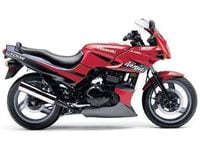For some riders, calling any motorcycle "practical" and "a good value" is like being told your blind date has a "nice personality": It almost certainly means disappointment is on the way. But there was a time when bikes with these attributes were plentiful and popular, before flashier bikes with newer technology shouldered them into the also-ran category. Today, for commuters, beginners, and riders looking for a stablemate for their high-strung weekend warrior, bikes like the Yamaha Seca II are still worth considering.
The Seca’s 599cc air-cooled engine had modest specs—dual overhead cams, two valves per cylinder, 28mm Mikunis, six-speed gearbox—and produced 61 hp at 8,500 rpm. Although sometimes accused of having a bland powerband, the little four was as happy as a warm puppy at practically any speed, making it easy for beginners to concentrate on other things, like the odometer ticking off the miles; there are scads of XJs running to 50,000 miles with only the most basic maintenance. Rackety high-mileage engines can often be quieted with a carb synchronization or valve adjustment—mercifully easy given the bike’s shim-over-bucket valve train.
But if the starter spins without turning over the engine, it could be a stripped idler gear that can only be replaced after splitting the cases. The valve-cover and clutch-cover gaskets are the most common leak spots (and easily repairable), but first make sure the engine wasn’t run for long with insufficient oil.
Like its engine, the Seca’s tubular-steel chassis lacks flash but gets the job done with a 38mm non-adjustable fork, a preload-adjustable single rear shock, and a duo of disc brakes: a 320mm rotor with a two-piston caliper up front and a 245mm disc with a one-piston caliper in the rear. The cast wheels wear a 110/80-17 front tire and 130/70-18 rear—bias-ply, even back in 1992. The seat is 30.3 inches off the ground and nothing to write home about, but it’s big enough to accommodate a rider and a passenger for short two-up stints. Gassed up, the Seca tips the scales at 435 pounds and returns gas mileage in the mid-40s to -50s.
The swoopy fairing does a pretty good job of keeping the worst of the weather at bay, but it’s expensive to replace, so examine it closely for damage, especially cracks around the mounting points and in the windscreen. Check the fuel petcock; a leaky one can cause the above-mentioned starter idler gear to shred its teeth if you crank the engine over with flooded cylinders. Plus, well, it’s messy.
The Seca’s reputation for reliability leads some owners to ignore routine maintenance altogether in favor of triage fixes. As with any used bike, check the chain and sprockets for worn teeth, kinked links, and general wear. Get under the bike and look for leaks. Check the steering-head and swingarm bearings for wear, and be on the lookout for signs of crash damage. If the bike has been sitting, check the inside of the tank for rust and the sidewalls of the tires for cracks. The Seca’s engine is as cold-blooded as a bank president and can take up to 10 minutes before it runs cleanly without the choke; if it doesn’t clear its throat after that something’s amiss.
Simple, basic, reliable transportation with enough character to keep you entertained.
Neither flashy, fast, nor fancy. If “practical” puts you off, pass on the Seca.
Non-starting starter, excessively lean running after warm-up, leaky petcock.
One of the original bargain blasters, still good fun today.
1992 | $975 1993 | $985 1994 | $1,000 1995 | $1,130 1996 | $1,180 1997 | $1,240 1998 | $1,335
If low maintenance is your guiding principle, the Honda Nighthawk's your bike, with hydraulic valve-lash compensation, shaft drive, and automatic cam-chain adjustment. Although more hot-roddy than some would prefer, with the meat of the powerband in the upper reaches of the rev range, it's a decent commuter and weekend tourer too.
One of Kawasaki's evergreen models, this twin-cylinder sportbike is a favorite of budget-conscious riders and those who don't need four cylinders to have fun. The seating position is nearer to standard than sportbike, and '94–later models got an upgraded fairing, wider wheels, and several reliability tweaks that can be installed on earlier models.
These do-it-all twins, the original naked Suzuki SV650 and the faired S model introduced in 2001, are still loved and sought after today. In the hands of a capable pilot, both can show their heels to sportier four-cylinder bikes in the twisties on weekends and easily revert to reliable workhorses the rest of the week.














/cloudfront-us-east-1.images.arcpublishing.com/octane/QSTCM6AVEZA5JJBUXNIQ3DSOF4.jpg)
/cloudfront-us-east-1.images.arcpublishing.com/octane/U4I7G625B5DMLF2DVIJDFZVV6M.jpg)
/cloudfront-us-east-1.images.arcpublishing.com/octane/B6XD6LS6IVCQPIU6HXDJSM3FHY.jpg)
/cloudfront-us-east-1.images.arcpublishing.com/octane/ICL63FEDDRDTTMINYICCEYGMDA.jpg)
/cloudfront-us-east-1.images.arcpublishing.com/octane/FCGZHQXRBZFLBAPC5SDIQLVF4I.jpg)
/cloudfront-us-east-1.images.arcpublishing.com/octane/WNOB6LDOIFFHJKPSVIWDYUGOPM.jpg)

/cloudfront-us-east-1.images.arcpublishing.com/octane/X33NU3E525ECRHXLNUJN2FTRKI.jpg)
/cloudfront-us-east-1.images.arcpublishing.com/octane/6KKT5NNL2JAVBOXMZYS5ZO76YA.jpg)
/cloudfront-us-east-1.images.arcpublishing.com/octane/J5RKG5O455GMPGQRF2OG6LRT7A.jpg)
/cloudfront-us-east-1.images.arcpublishing.com/octane/GX2CIZKQVRH2TATDM26KFG2DAE.jpg)
/cloudfront-us-east-1.images.arcpublishing.com/octane/ZWIDYSAKQZHD5BHREMQILXJCGM.jpg)
/cloudfront-us-east-1.images.arcpublishing.com/octane/CYUHJZCTSJCH3MRAQEIKXK7SCQ.jpg)
/cloudfront-us-east-1.images.arcpublishing.com/octane/LKOFINY56FCXJCANJ5M7ZDQUBY.jpg)
/cloudfront-us-east-1.images.arcpublishing.com/octane/4NBPDACMWJH63JQYJVK3QRBDZI.jpg)
/cloudfront-us-east-1.images.arcpublishing.com/octane/KKHQHRR3FJGX7H2IPU6RALMWG4.jpg)

/cloudfront-us-east-1.images.arcpublishing.com/octane/5IOFS5JAE5FOXMNA23ZRAVVYUU.jpg)
/cloudfront-us-east-1.images.arcpublishing.com/octane/CGXQ3O2VVJF7PGTYR3QICTLDLM.jpg)

/cloudfront-us-east-1.images.arcpublishing.com/octane/OQVCJOABCFC5NBEF2KIGRCV3XA.jpg)
/cloudfront-us-east-1.images.arcpublishing.com/octane/OPVQ7R4EFNCLRDPSQT4FBZCS2A.jpg)
/cloudfront-us-east-1.images.arcpublishing.com/octane/YBPFZBTAS5FJJBKOWC57QGEFDM.jpg)
/cloudfront-us-east-1.images.arcpublishing.com/octane/W5DVCJVUQVHZTN2DNYLI2UYW5U.jpg)